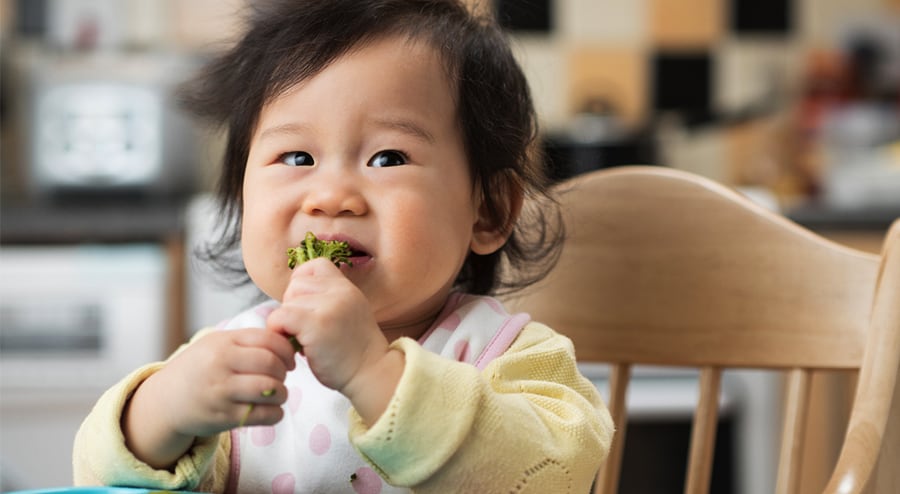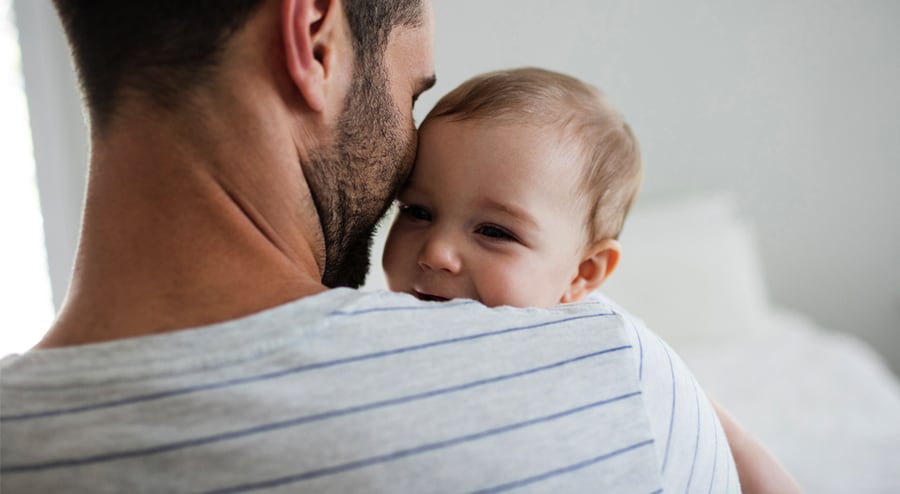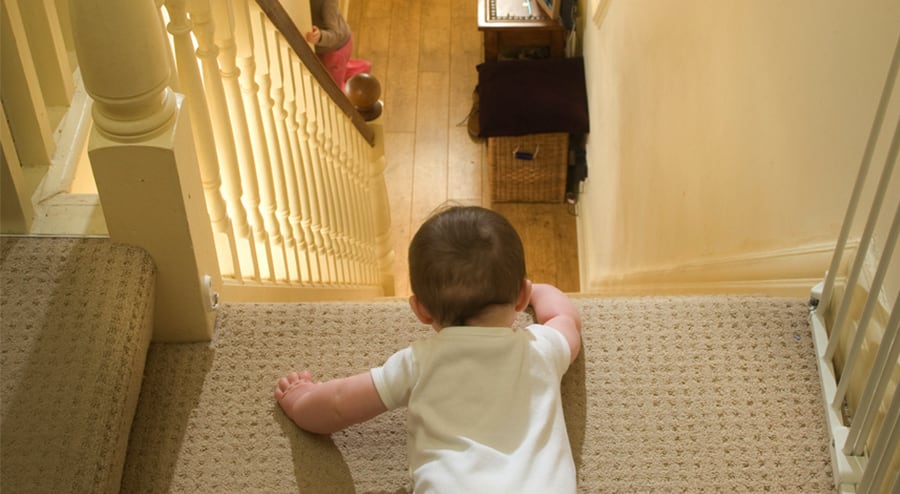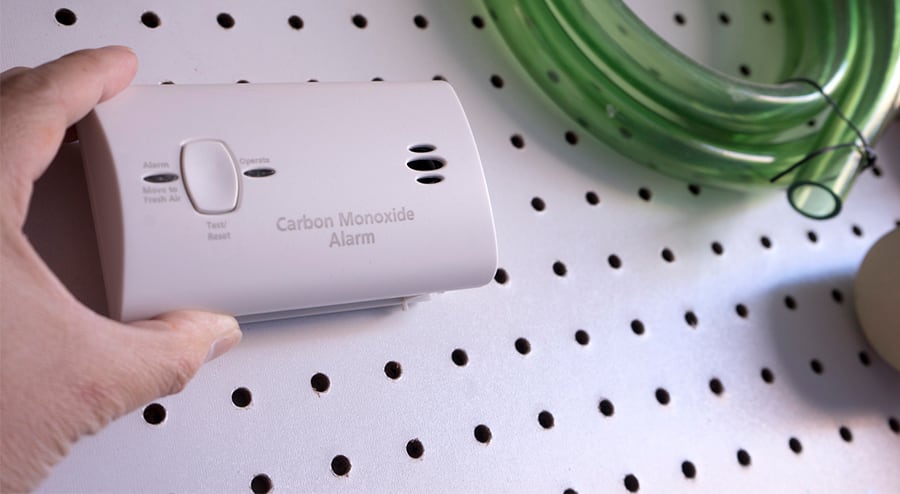Toddlers are curious, active people who don’t understand the risks in the world around them. And statistics show that there are risks particular to this age: children one to four years old have the highest rates of nonfatal falls and poisonings of any group of children younger than 19, and, unlike older children, are more susceptible to drowning than any other accidental death. As a parent or caregiver, it’s your responsibility to keep your toddler safe from the many hazards found around the house, but fortunately a little foresight and some simple steps can make your home safe for your newly-mobile child.
Eating and Choking
Toddlers like to stuff their mouths full of food, not realizing that they put themselves at risk for choking. Keeping toddlers safe requires close monitoring and careful food choices.
- Avoid feeding your child whole grapes, whole hotdogs, hard candy, or foods that involve big gobs of peanut butter. Cut up foods into small pieces to prevent your child from choking, and give your child food in small portions.
- Do not let your toddler eat and run around the house at the same time, and do not allow your toddler to drink while lying down.
- Model good eating habits for your toddler, and always watch your child carefully while he or she eats.
- Get CPR certified and know what to do in the even that your child begins to choke.
Toys
Food isn’t the only issue when it comes to choking. Toddlers who swallow toy parts or who chew paint off of their toys can be at risk for choking—and for poisonings. As your child grows into a new collection of toys, keep the following tips in mind.
- Check the recommended ages for a toy before giving it to your toddler; never give your toddler a toy intended for use by older children.
- Check safety ratings and reviews before giving your toddler a toy.
- Throw away toys that have begun to chip, splinter or break.
Safety from Poisons
Like babies, toddlers like to explore their world by placing objects in their mouths—but unlike babies, toddlers have the mobility to come in contact with a far larger range of substances. For this reason, there are a variety of household products and plants that can poison your toddler. To keep your child safe, keep him or her away from anything that could be toxic if swallowed.
- Use child-proof locks on cabinets that contain cleaning products and other toxic chemicals.
- If possible, put up toxic chemicals so they are out of your child’s reach
- Familiarize yourself with common toxic plants. Shrubs that produce poisonous berries (like holly) can be especially dangerous. Remove all toxic plants from your property.
- Baby-proof your garage as well as your house. Put up or lock away chemicals like antifreeze.
- Take a first aid class to ensure that you know what to do if your child swallows toxic chemicals.
- Call poison control immediately if your child drinks a toxic substance.
Kitchen Safety
Many toddlers love digging through drawers and cabinets in the kitchen. Unfortunately, toddlers are at risk for a variety of injuries in the kitchen, including cuts, burns and ingestion of poisons.
- Use child-safe locks on drawers and cabinets.
- Do not allow cords from countertop appliances to dangle off of the counters.
- Keep knife handles away from the edges of counters.
- Do not balance sharp knives or heavy dishes in the dish drainer or on the edge of the counter.
Burns
Toddlers are curious people, often reaching to turn dials and push buttons, and toddlers who play with hot water faucets or stove top dials can be seriously burned. 200,000 children under four years old are scalded every year, and 1,100 children die from burns annually. Keeping toddlers away from flames, hot surfaces, and hot water can protect your child from a serious injury.
- Keep a baby gate over the kitchen and bathroom doors to restrict access.
- Monitor your child closely while he or she is in the bathroom or kitchen.
- Do not allow your child in the kitchen while you are cooking.
- Do not place pots on the stove with their handles facing out toward the room.
- Use back burners on the stove more often than front burners.
- If your child is burned, run cold water over the burn for 20 minutes. Contact your child’s doctor if the burn is larger than a quarter.
Falls
Falls are the leading non-fatal cause of injury for children who are less than 15 years old. Falls can happen on stairs, out windows and even on flat surfaces. For toddlers just learning to walk, falls are very common.
- Position child gates at the top and bottom of staircases.
- Teach toddlers to use handrails when walking up and down stairs.
- Install child guards on windows without screens.
- Lay down rugs in parts of the house where your toddler frequently runs or walks.
Pool Safety
Drowning is a particular risk for children aged 1-4. According to the Centers for Disease Control (CDC), drowning is the number one cause of accidental fatalities among children of this age. If you have a backyard pool, these tips will help you protect your child from injury:
- Keep the gate around the pool locked at all times.
- Install a safety net over the pool to prevent your child from falling in.
- Sign your toddler up for swim lessons to teach basic safety.
Bathing Safety
Bath time is a fun time for most toddlers. Keeping your child safe during bath time can help make this a special part of your child’s day.
- Never leave your toddler unattended in the bath.
- Put a foam guard around the faucet to prevent your child from bumping his or her head.
- Turn down your water heater temperature to 120° or lower.
- Buy a safety lock for the faucet to prevent your child from turning on the hot water.
- Buy soaps and shampoos designed for toddlers.
- Watch for any rashes after bathing your toddler (some soaps can cause problems for children with skin sensitivities).
Fireplace
The fireplace can be a serious source of danger to children who are not old enough to understand fire and its risks. The best way to protect your toddler from the fireplace is to secure a child-safe gate in front of the hearth. This prevents your child from accessing the fireplace or the space around the fireplace.
- Never leave your child unattended with a fire burning in the fireplace.
- Keep the screen shut to prevent your toddler from throwing anything into the fireplace opening.
- Keep hot fireplace tools out of reach from your toddler.
Smoke and Carbon Monoxide Detectors
Smoke and carbon monoxide detectors keep children safe from fire and carbon monoxide poisoning. Some devices combine smoke and carbon monoxide into one detector.
- Place a smoke and carbon monoxide detector inside and outside your child’s bedroom to alert you and your child in the event of an emergency.
- Check batteries every six months; replace as needed.
- Keep one type of each detector on all floors of your house.
Car Seat Safety
Traffic accident fatalities are a major risk for death and injury for children of all ages, and using the proper car seat is one of the best steps parents can take to keep their child falling victim to a car crash. Car seats come in a variety of types, from baby car seats to toddler convertible models: most are designed to be rear-facing until a child reaches a certain height and weight, after which time the car seat is faced forward. Parents should keep toddlers in a rear-facing position for as long as possible. Most new car seats allow the child to stay rear facing until he or she reaches 40 pounds.
- Familiarize yourself with the height and weight requirements specified by your child’s car seat manufacturer.
- Follow all car seat installation instructions.
- Have your car seat inspected by a car seat expert or by your local police department to ensure that it is properly installed.
- Never put the car seat in the front seat of a vehicle with a passenger-side airbag.
- Dress your toddler in thin layers of clothing before putting him or her in the car seat.
Guns and Firearm Safety
It hardly seems possible, but toddlers are involved in dozens of accidental shootings every year. Parents who keep firearms in the house with their children run the risk that their toddler will discover their weapons, and while older children can be taught gun safety, toddlers’ brains have not developed enough to rely on them to police themselves. Keeping guns away from your toddler is the only true way to keep him or her safe.
- Keep guns locked and out of reach from your toddler.
- Store ammunition separately from the gun.
- Keep your gun secure in a locked box.
Educate Your Toddler
One of the best ways to keep your toddler safe is to teach him or her about personal safety. While keeping in mind that your toddler may not remember what you tell them about a particular risk, take opportunities to model safe behavior and point out safety lessons throughout the day as issues arise. Sharing books about staying safe is also an effective method of helping your child become more aware of the dangers around him. After all, while you want to keep your child safe now, you’ll also want to start teaching him to keep himself safe in the years to come.
Sources
https://www.washingtonpost.com/news/wonk/wp/2014/10/01/92-of-patients-say-medical-marijuana-works/?utm_term=.60c6e767d43f
https://www.cancer.org/treatment/treatments-and-side-effects/complementary-and-alternative-medicine/marijuana-and-cancer.html
https://www.ncbi.nlm.nih.gov/pmc/articles/PMC3180521/
https://www.cancer.gov/about-cancer/treatment/cam/patient/cannabis-pdq#link/_7
https://www.alz.org/facts/
https://content.iospress.com/articles/journal-of-alzheimers-disease/jad140093
https://www.cbsnews.com/news/seniors-and-marijuana/
http://www.businessinsider.com/medical-marijuana-effective-treatment-chronic-pain-2017-1
https://www.drugabuse.gov/publications/research-reports/prescription-drugs/trends-in-prescription-drug-abuse/older-adults
time.com/4419003/can-medical-marijuana-help-end-the-opioid-epidemic/
https://www.health.harvard.edu/mind-and-mood/medical-marijuana-and-the-mind
https://www.drugabuse.gov/publications/drugfacts/marijuana-medicine
https://www.eatingdisorderhope.com/blog/chronic-illness-and-eating-disorder-development-in-the-elderly-patient
https://www.psychologytoday.com/blog/your-brain-food/201204/the-connection-between-anorexia-bulimia-and-marijuana
https://www.vice.com/en_us/article/wd7jwx/should-weed-be-used-to-treat-eating-disorders-511
https://www.aao.org/eye-health/diseases/what-is-glaucoma
https://www.aao.org/eye-health/tips-prevention/medical-marijuana-glaucoma-treament
http://www.oregoneyes.net/glaucoma-and-marijuana/
https://www.scientificamerican.com/article/marijuana-may-boost-rather-than-dull-the-elderly-brain/
http://onlinelibrary.wiley.com/doi/10.1111/add.13670/full
http://abcnews.go.com/Health/story?id=118104&page=1
http://www.thecannabist.co/2016/07/27/legal-marijuana-sales-annually/59505/
https://www.healthline.com/health-news/why-are-more-seniors-using-marijuana#5
https://www.forbes.com/sites/carolynrosenblatt/2017/08/21/can-medical-marijuana-help-aging-parents-insomnia/#67ed5d4927ce
https://www.forbes.com/sites/mikemontgomery/2017/07/19/edibles-are-the-next-big-thing-for-pot-entrepreneurs/#2b8d6969576b
https://www.justice.gov/opa/pr/justice-department-announces-update-marijuana-enforcement-policy
http://www.ncsl.org/research/health/state-medical-marijuana-laws.aspx
You Might Also Like
Toddlers who swallow toy parts or who chew paint off of their toys can be at risk for choking and for poisonings.
You May Also Like
Resources | About Us | Contact Us
877-664-6140
1530 WILSON BLVD., ARLINGTON, VA, 22209





